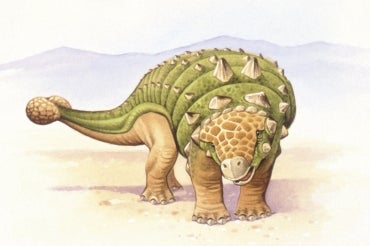Where did animals with tail weapons go? U of T expert does the research

Published: January 17, 2018
Why is it that many dinosaurs had formidable tail weapons – such as the ankylosaurus, with its clubbed tail, and the stegosaurus, with its spear-like spikes – but animals today do not?
Victoria Arbour, a paleontologist at the University of Toronto and the ROM, decided to figure out why. With Lindsay Zanno, a paleontologist from North Carolina State University, the researcher compiled data about nearly 300 mammals, reptiles, birds and dinosaurs, both extinct and living, looking for commonalities, according to a report in the New York Times.
The Times reports that the team identified three characteristics in land-dwelling mammals, reptiles and nonavian dinosaurs that may be linked with evolving bony tail weapons: being large (the size of a mountain goat or bigger), eating plants and already having an armoured body.
“That’s a really rare combination no matter what time period you’re looking at,” Arbour told the Times.
The research was published Wednesday in the Proceedings of the Royal Society B.
Many modern animals that use tails as weapons – like porcupines – have tails made of keratin, not bone. Modern lizards like iguanas, which can lash their tails, do not have spikes.
Read the full New York Times report
Read the research


